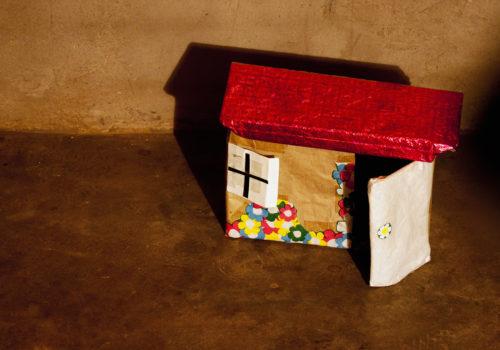Text by Marie Meyerding
“Into the Light” is the theme which curator Amè Bell chose to present South Africa in Venice this year. Next to Roger Ballen and Phumulani Ntuli, Lebohang Kganye exhibits one of her first photography series on the upper floor in Arsenale. Fourteen photographs of different sizes are displayed in various formats. Dark walls and narrow corridors underline the intimacy of the gold shimmering photographs illuminated by spotlights. Produced towards the end of her studies at the Market Photo Workshop in 2011, B(l)ack to Fairy Tales weaves together personal histories and visual archives from Kganye’s family background through self-portraiture. Thereby, a formula emerges that many of her subsequent works will follow.
In B(l)ack to Fairy Tales, Kganye explores the influence of Western fairy tales during her childhood. Identifying with the character of Snow White as a girl, Kganye describes how her black skin and her surroundings contrasted with her fantasies, both in terms of her idols’ appearances and their living conditions. She reflects how ‘ideas of romance and happy endings […] are at odds with my life growing up in a Black township.’ To stage this absurdity and its intangibility, Kganye presents herself in her grandmother’s house, where she grew up, with expressively black painted skin, eccentric costumes, and some of her old childhood toys in mostly blurred pictures. Wearing dresses and striking red lipstick mark Kganye’s performances as distinctly gendered.
The blurring appears in different states, referencing not only the elusiveness of memories but also their difficult relationship to truth claims and fact-based evidence. Photography negotiates this difficult relationship, making it the ideal medium for Kganye—whose name indirectly connects her to the medium, as it means ‘light’ in Sotho—to continuously explore her family’s history. In 2013, Kganye created her two-part series Ke Lefa Laka, in which she imitates her deceased mother in found photographs on the one hand and re-enacts her grandfather’s life under apartheid on the other. The latter forms the basis for Kganye’s first film Pied Piper’s Voyage (2014) which many others have followed to date, Dipina tsa Kganya (2021) being her latest work. Similarly based on her ancestor’s visual and oral traces, as well as African literature dealing with possible transcripts of realities as in In Search for Memory (2020), these subsequent works, their thematic references to identity politics and their visualisation through an overemphasis on shadow and light can already be found in B(l)ack to Fairy Tales.
Two of the series’ photographs do not show Kganye directly: Untitled 5 features a house made from different papers while Untitled 1 solely reveals the artist’s shadow. Yet, these pictures do not depict less of the artist—on the contrary, only through their inclusion it becomes clear how little these self-portraits live from Kganye’s physical presence. To better understand how some African societies apprehend reality, Oyèrónkẹ́ Oyěwùmí introduces the concept of a ‘world-sense’ in her text ‘Visualizing the Body.’ Against the Eurocentric ‘worldview’ and its connections between overemphasised visuality and patriarchy, this concept ‘does not privilege the physical world over the metaphysical.’ With works such as Untitled 3 showing the uncanny appearance of large radiant-transparent wings behind her body, Kganye’s series masterly demonstrates that photography is a well-suited medium like no other to capture the gendered body between the physical and the metaphysical. Equally critical and playful, Kganye brings gender-political identities emerging from the interconnectedness of global and local influences and the resulting dissonances into the light.
Marie Meyerding
















